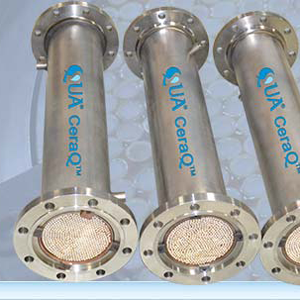 Katlyn Graham: Hello, I’m Katlyn Graham, here with VJ Nathan, the technical director at QUA. Welcome, VJ.
Katlyn Graham: Hello, I’m Katlyn Graham, here with VJ Nathan, the technical director at QUA. Welcome, VJ.
VJ Nathan: Thank you, Katlyn.
Katlyn: Thanks for joining us. Today, we’re discussing one of QUA’s products, the CeraQ ceramic filter. VJ, what is the ceramic membrane filter?
VJ: Ceramic membrane filters are basically ultrafiltration or microfiltration filters similar to the polymeric membrane filters, which can treat challenging wastewater, even water at higher elevated temperature.
If you want to know how these membranes are produced, ceramic membrane filters are basically produced from inorganic material such as aluminum oxide, silicon carbide, titanium oxide, or zirconium oxide.
The membrane porous core material is first formed through extrusion process which becomes the support structure for the ceramic membrane.
The coatings are then applied to the inner face or the filtering face with the same ceramic particle or sometime different, depending on the application.
Examples, suppose if your core material is aluminum oxide, you use the aluminum oxide particles also to apply the coating.
The ceramic particles size used for the coating, which is also called a layering, as well as the number of coating you apply will determine the pore size of the membrane as well as the distribution characteristics.
The coating material after application to the core we then sinter at a high temperature in a furnace, making the membrane layer integral to the core support structure, providing a very durable and hard surface.
This sintered bonding ensures a very long life for the membrane and is not disturbed even under challenging feed water conditions.
The ceramic membranes can be custom produced from microfiltration range to ultrafiltration range by varying the number of coatings and by using the right particle size for the coating.
QUA manufactures the CeraQ tubular filtration membrane filters, which we can manufacture in both microfiltration range, or in the ultrafiltration range depending on the customer requirement. Our standard pore sizes can vary from 0.4 microns to .01 micron size.
Katlyn: What does the CeraQ ceramic filter do that other filters can’t do?
VJ: The ceramic filters are basically like glass, making it very hard and durable, unlike the polymeric membrane. This gives the ceramic membrane a very high mechanical strength. The ceramic membranes are chemically inert. It can be operated at a very high flux compared to the polymeric membrane.
The ceramic membranes can be very vigorously cleaned. Also, the membranes are thermally stable. Even if you want, you can clean it with hot water or steam, which is not possible with the polymeric membrane.
The ceramic membrane also has a very long operation life, almost three to four times compared to the polymeric membrane. Thus any feed water source with very high fouling tendency, which is at an elevated temperature where simply the polymeric membrane cannot be used, ceramic can very easily treat it.
Katlyn: I see. You would reference that wastewater industries often use the CeraQ. Is using the ceramic filter economical?
VJ: Ceramic filters are very expensive compared to polymeric. Normally, the understanding is the ceramic filtration application starts where the polymeric ends. A lot of the ceramic membrane, the market were originally developed for very high‑end users, and was not able to achieve the economics required for the water industry. However, this is not the case anymore.
CeraQ was developed with water industry in mind, and therefore, is more competitive. Based on the life cycle cost evaluation, the ceramic membrane can be on par, or even cheaper than polymeric membrane in some of the applications.
Katlyn: If you have a high temperature water, or like you said, if you need it to hold, it has a longer life than some of the polymer membranes.
VJ: Exactly, or in case of a very seriously fouling free water condition.
Katlyn: Who normally uses the CeraQ membrane?
VJ: The ceramic membrane has various applications, mostly in treating very difficult to treat water and wastewater, or where high temperature operation is involved. The ceramic membrane at this moment is a very viable technology for produced water treatment.
It has vast application in oil and gas, wastewater recycle, as a pre‑treatment for RO, and for removing precipitated metals from any precipitation process. For oil/water separation, and food and beverage industry, and pharmaceutical industry. In mining where you have to treat the wasted tailing ponds, ballast water treatments.
It has got a whole lot of application, and each application has to be studied, and a proper solution can be found with using this membrane as a part of the treatment scheme.
Katlyn: I see. You have to look at the industry and then specify the membrane for that industry?
VJ: Exactly. Example I will tell you right now, for oil/water separation in produced water application, we have a whole host of processes to clean the wastewater. You have a CPI separator, and then you have a dissolved air flotation unit, or an induced air flotation unit followed by a walnut shell filter.
If you can apply the ceramic membrane filter, probably you don’t need these three unit processes. You can feed the produced water right out of the skimming tank.
This is how, even though the ceramic membrane filter asset may be a little expensive, but if you can remove three of the unit processes, and replace with just one unit process, it will definitely provide the necessary economy as well as ease of operation.
Katlyn: That’s a great example, VJ. Thank you so much for explaining all this about the CeraQ to us. I appreciate it.
VJ: Thank you very much.

